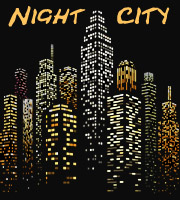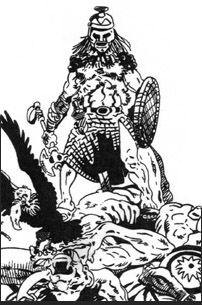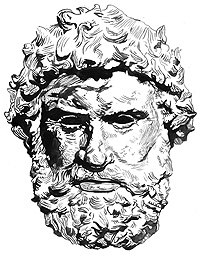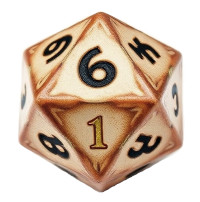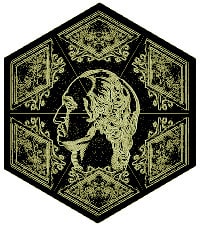Most ‘barbarians’ that an adventurer in 650 B.C. Hellas would encounter would be the men from the wooded hinterlands who were so ubiquitous that they comprised a military type—the ‘peltast’, which is covered under Panoply.
I will devote this chapter to two questions that would be utmost in the mind of the video game designer, novelist or RPG player interest in this period. This book is a distillation of the three history books I wrote in 2010 on the history of ancient boxing and prizefighting, The Broken Dance. I am working from those texts and will therefore not bother footnoting and referencing sources, but would refer the reader to those books. The primary sources I worked from are listed in the appendices.
The Indo-Europeans
From the Thames to the Nile, to the Ganges history from 1700 B.C. through 550 B.C. was largely shaped by the invasions of the Indo-Europeans [who were called the Arуans in India]. These waves of nomad invaders utilized the chariot, pulled by a team of small horses as a weapons platform for the use of the composite bow—the third of the five great innovations in ranged killing between 70,000 B.C. and 1945 [atlatl, bow, composite bow, chemical weapons, atomic weapons]—and as battle taxies for carrying heavily armed foot soldiers into battle.
The infusion of this technology came as part of a cultural package that included wrestling, boxing, the horse, metallurgy, and the reverence of sky gods over earth deities—in particular a jealous patriarchal sky god prone to rape and genocide and fond of tossing lightning bolts and fire to earth—Curtis Lemay/Larry Flint as God.
Migrations can be traced through the cosmology. I shall chart the rough Hellenic progression of cultural assimilation as indicated by the religious record. Syncretism is the process by which the deities of conquered peoples were assimilated into the family of the gods. Deification followed a three step process: heroization [Michael Jordon], demigod [Gilgamesh, Herakles, Jesus—don’t worry, I have not forgotten his promotion], and deification [Odin, Zeus, etc.]. a fourth step would be the monotheistic notion, which was quite alien to the ancients as cultural and genetic lineage was vested in the individual gods, and to deny or extinguish a god was to deny or extinguish a people. The Syncretic notion postulates the many faces of a single God, rather than the faceless exclusive God that we moderns relate the term to.
1. In the Hellenic world your first sky god seems to have been Poseidon, who lost his sky god throne and was demoted to lifeguard of the gods, and still suffers the indignity of having canned sardines stamped with the Latinized version of his name. He was, however, still ‘Breaker of Horses’, as was Hektor, sacrificial prince of defeated Troy. The ‘Horse beaker’ appellation indicates that Poseidon was the deity of the first horse people.
2. The second, and supreme sky god, was Zeus [Thunder-lord]. Zeus was the older brother of Poseidon and his sacred animal was the bull; cattle, symbol of wealth among nomads. Zeus represents a second wave of more successful horse people.
3. Apollo or Helios is regarded as ‘the best’ of the sky gods, and Zeus’ prized son. He was said to have out boxed Ares [perennial multicultural psychopath of the gods] and to have outrun Hermes, fastest of the gods. He is the god of excellence, he whose people does it better. Apollo was said to have defeated a tax collecting Titan, Phorbas, indicating that his people were originally subject peoples to the greater horse culture—new arrivals, like the Mexican cook in the kitchen of the Italian restaurant who does better chicken cacciatore than the boxer that founded it. His sacred animal is the wolf, indicating a period of border dwelling and raiding by his people before their assimilation under the established horse-people. He is also the god of archery and plagues, meaning he came by war, and came from the hinter land, where archers are always better than their more settled counterparts.
4. Apollo’s bestiality inclined son Kentaurus was said to have fathered the race of centaurs, half horse/half man [possibly a metaphor for Indo-European kings screwing sacrificial mares]. Stories of the Lapiths boxing [this being a metaphor for the triumph of excellence over savagery] against raiding centaurs are common to the archaic period. The appearance of the centaurs in literature after 700 is associated with the first appearance of horses large enough to be ridden. As with the Aztecs, upon first seeing horsemen, the initial impression was one of a man-beast, some cruel symbiotic blasphemy of nature. This last wave of immigrants out of the steppes were the Skythians, who ranged from Hungary to Siberia and were known to the Greeks and Persians as enemies based around the Black and Caspian Seas. Cyrus, founder of Persia, was killed fighting these people, and was thought by some to have been lured or slain by female enemies, or by warriors in service to a nomad queen.
Skythians
It would be best to think in terms of plains Indians before the introduction of firearms, including the wearing of buckskins and the taking of scalps. The Skythians where bearded Caucasians who used a powerful bow and light hand weapons: daggers, knives, long handled light axes, and possibly some light curved swords for the rich warrior. The Skythians provided the city of Athens with their police force and are accurately depicted in Gene Wolfe’s Soldier of Arete and my novel Behind the Sunset Veil. The Skythians could provide a more Nordic view of humanity closer to the modern Westerner’s view of sex and gender than that of the Hellenes.
Amazons
A story of Achilles’ father Peleus wrestling Atlanta the Amazon goes back into mythic prehistoric times. This either represents Indo-European horse warriors interacting with Kelts and Germans of the wooded lands whose women had much higher status than amongst the nomads, or a residual dread of the priestesses of Crete, who had mastered their men through religion, drugs, alcohol and sex and perished by volcano.
The actual legend of the Amazons as explored by Steven Pressfield in Last of the Amazons, and Gene Wolfe in Soldier of Arete, in which Amazons are the female half of a tribe of horse archers segregated by gender, is likely a Hellenic interpretation of women warriors on the backs of small horses, fighting with weapons. Of course, considering the Greek sexual appetite for boys these might have been youthful male scouts or horse wranglers. Greek women were segregated from the men in most things. They did not even sleep together. Think about that. The myth of gender segregation and of women fighting by themselves and not alongside their men, is bullshit—a Greek fantasy with as much basis in fact as Umma Thermon slicing up 50 ninjas.
In the era of muscle powered weapons only the most remarkable top 5% of women could find a use on the battlefield as other than a cheerleader or medic. Even the best female warrior—and there were some according to grave good evidence—was still not a top fighter. A unit of all female warriors would get steamrolled. Female warriors would be integrated with men. For the most part, even in societies where women had a proactive social role like Sparta, women in combat would remain unthinkable—mostly because it was so stupid and dysgenic.
An exception would be during that transition from chariot horse to war pony when the biggest and best warriors were still too damned big to ride far and fast without breaking down their mount. Female riders—those few who were strong enough to draw the composite bow—would make excellent scouts and flankers, and give the men someone to screw in camp.
Realistic Amazons
If young would like to have all female units of Amazons I suggest looking into Plains Indian culture and modeling your amazons not on an entire bifurcated tribe, but on the warrior societies of the Native Americans. The clothing and weapons would be similar.
If you wish to do an interpretation of Amazons living and fighting in the chariot age make them the horseback scouts of chariot warriors, able to ride horses that could not carry an armed man. They would not be ass-kicking machines but lightly armed spies and messengers.
The so-called Amazons of Dahomey were a troop of musketeers who served as the king’s personal bodyguard. The local culture was not conducive to a strong warrior ethic and the fact that women of West African extraction have larger bones and body mass than Polish and Icelandic men made them passable warrior women until the French Foreign legion landed and ended up marrying them after beating them. In sick emasculated societies with chemical powered weapons female warriors are viable, though mediocre at best.
The Amazon Warband
Structure: The band is commanded by a man and his wife or sister, who would handle the female members. This would be a seasonal raiding party expected to be in the field for 1 to 3 months. Horse people require 5 to 8 mounts per rider. Let’s make it 6. Men and women are paired off before leaving. There are two different age groups, the youths in their teens and the experienced raiders in their 20s, with the leadership perhaps as old as 35.
Main Force: The larger men and mature women would comprise the main body, with the mature women who have had children or are barren, managing the heard. The larger men would often dismount to fight, or quickly fatigue their mounts. In either case it would be his woman’s job to ride in with a fresh mount or to pick him up for a retreat or advance. Women in the main body would strictly be support troops like women in the military today, managing the transport, supply, gear, and also providing medical attention. Women of traditional nomad peoples held much more power than sedentary women as the job of managing the household—since it was a mobile command center, MASH unit and supply depot—was part and parcel of nomad warfare. Expect the women of the main force to handle as many as 10 mounts to free the men up to fight and maneuver.
Outriders: Smaller men and virgins would be assigned to scouting, raiding, messenger and pursuit duty. Women who have had children would be retired from the ranks or advanced to the main force. A woman’s right breast would not have to be removed as women cannot handle heavy draw bows and the composite bow is not drawn to the chin but to the cheek. If she had breasts so large that they got in the way of drawing a bow she would serve best as a wet nurse or as a bed warmer for the chief. Also, a large breasted woman would be too heavy for the speed advantage that would accrue to women and make them eligible for this duty. I see such a tradition as a rite of passage that would probably only be undertaken once by a women, and when she returned from campaign pregnant, would retire to camp life, which was no picnic and basically meant being a cowhand.
Tactics: These are raiding parties who behaved more like a pride of lions than any type of military unit the general reader would be familiar with. The tactics of Civil War Confederate Cavalry and Comanche warriors come to mind. The weapons will be covered under panoply. The female warrior’s bow would be of lighter draw. However it could still kill—even transfix—an enemy and would be shot from the flanks into the unprotected side of an enemy, or at their backs as they fled. The main force would describe a ‘bull’s head’ with larger men dismounting to fight, as the outriders formed the bull’s horns and enveloped the enemy. The value of the female horse warrior is due to her light weight, who, like the modern jockey, is chosen for his ability to get the most out of her mount. Without their mounts these people are dead meat on the battlefield. With their mounts they proved a match for the army of Alexander, and might have killed Cyrus the Great.
Logistics: One thing that is never taken into account in movies for instance is the thing that ancient warriors most concerned themselves with; How do we get there without starving and then get back alive with all the loot?
Think of the nomad horse archer warband like a post apocalyptic band of raiders whose advantage lies in their vehicles. However, there is no more fuel for the trucks and fighting vehicles. Instead, the vehicle engines have been converted to burn asphalt—the petroleum based road aggregate that paves our highways. Imagine having to eat your road, and being in danger of running out of fuel and being trapped upon leaving the road. The road of the ancient horse warrior was the grassland.
In the end, whether you are a man or a woman horse warrior, it is the horse that makes you effective. Where most authors would write in bogus gender-based arguments I would expect more male-female cooperation than you typically see in modern workplaces, and if there was an argument, it would come down to a debate over the horses and their needs.


